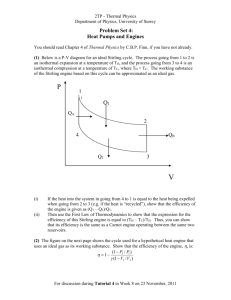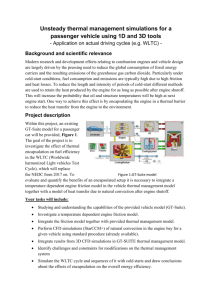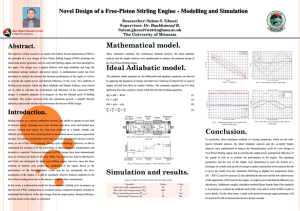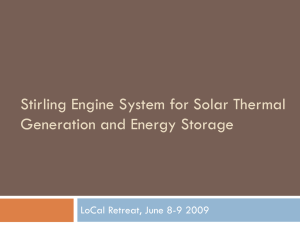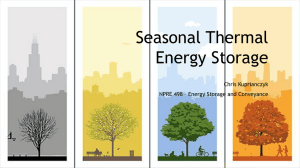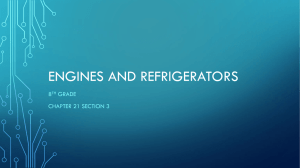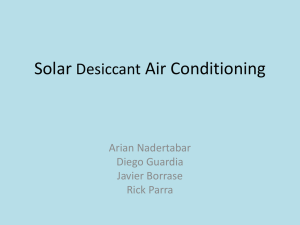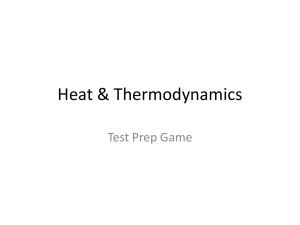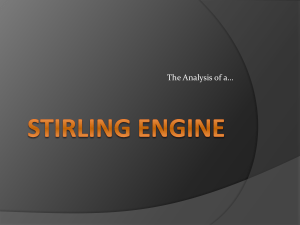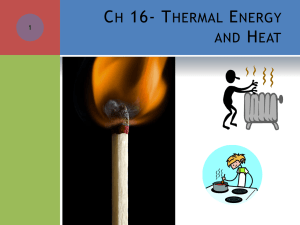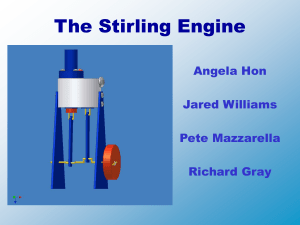LoCal-Jun2011-Retreat-Presentation
advertisement
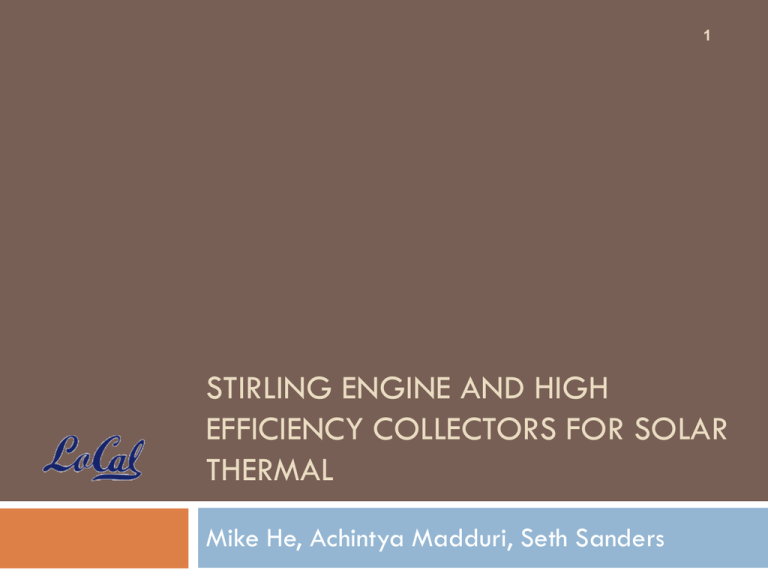
1 STIRLING ENGINE AND HIGH EFFICIENCY COLLECTORS FOR SOLAR THERMAL Mike He, Achintya Madduri, Seth Sanders Motivation 2 Thermal storage is highly dense, cost-effective Flexible input – can use gas, solar, or electricity Storage medium is cheap Contributes to building slack Predictable, controllable generation Reversible process allows off-peak storage Can reduce fossil fuel footprint Can use solar input Waste heat can be utilized System Schematic 3 Non-tracking collector Low cost Thermal energy storage Stirling engine generates electricity, waste heat Project Goals 4 Design, Build, and Test Stirling engine prototype to demonstrate efficiency and low cost Design and test passive concentrator design for higher efficiency Evaluate commercialization potential Novel Design Challenges 5 Designing for high efficiency, given low temperatures from distributed solar High importance of low cost and long lifetime design Improve commercially available collectors with passive concentrators Stirling Cycle Overview 6 4 1 2 3 Heat Exchanger Design 7 Component Hot-side Liquid to Metal Temperature Drop (C) 1.79 Hot-side Metal to Air 1.26 Cold-side Liquid to Metal 2.42 Cold-side Metal to Air 1.09 Design characteristics 8 Design Characteristics Nominal Power Output Thermal-Electric Efficiency Fraction of Carnot Efficiency Hot Side Temperature Cold Side Temperature Working Gas (Air) Pressure Engine Frequency Electrical Output Regenerator Effectiveness Piston Swept Volume Value 2.525 kW 21.5% 65% 180 oC 30 oC 25 bar 20 Hz 60Hz, 3φ 0.9967 2.2 L Design and Fabrication 9 Prototype Pictures 10 Collector and Engine Efficiency 11 Collector with concentration G = 1000 W/m2 (PV standard) Schott ETC-16 collector Engine: 2/3 of Carnot eff. No Concentration Concentrator for Evacuated Tube Absorber 12 Passive involute-shaped concentrator Produces concentration ratio ~pi in ideal case Can reduce # tubes by concentration ratio Lowers losses and/or increases operating temperature, improving efficiency Evacuated Tube Absorber 13 Collector testing system 14 15 Questions Cost Comparison – no concentration 16 Solar Thermal Component Collector Engine Installation -Hardware -Labor Total Photovoltaic $/W 0.95 0.5 0.75 1.25 $3.45 Component PV Module Inverter Installation -Hardware -Labor Total $/W 4.84 0.72 0.75 1.25 $7.56 With concentrator: expect substantial cost and area reduction due to efficiency increase Source: PV data from Solarbuzz 17 Electrical/Thermal Conversion and Storage Technology and Opportunities 18 Electricity Arbitrage – diurnal and faster time scales LoCal market structure provides framework for valuation Demand Charges avoided Co-location with variable loads/sources relieves congestion Avoided costs of transmission/distribution upgrades and losses in distribution/transmission Power Quality – aids availability, reliability, reactive power Islanding potential – controlling frequency, clearing faults Ancilliary services – stability enhancement, spinning reserve Comparison of Water Heating Options 19 “Consumer Guide to Home Energy Savings: Condensed Online Version” American Council for an Energy-Efficient Economy. August 2007. <http://www.aceee.org/Consumerguide/waterheating.htm >. Ex. 3: Waste heat recovery + thermal storage 20 Waste heat stream 100-250 C or higher Thermal Reservoir Electric generation on demand Heat Engine Converter Domestic Hot Water ? •Huge opportunity in waste heat Thermal System Diagram 21 Solar Dish: 2-axis track, focus directly on receiver (engine heat exchanger) 22 Photo courtesy of Stirling Energy Systems. Stirling Cycle Overview 23 4 1 2 3 Residential Example 24 30 sqm collector => 3 kWe at 10% electrical system eff. 15 kW thermal input. Reject 12 kW thermal power at peak. Much larger than normal residential hot water systems – would provide year round hot water, and perhaps space heating Hot side thermal storage can use insulated (pressurized) hot water storage tank. Enables 24 hr electric generation on demand. Another mode: heat engine is bilateral – can store energy when low cost electricity is available. Potential for very high cyclability. 25 Displacer Temperatures: Working fluid: Frequency: Pistons – Stroke: – Diameter: Power piston Th=175 oC, Tk=25 oC Air @ ambient pressure 3 Hz 15 cm 10 cm Indicated power: – Schmidt analysis – Adiabatic model 75 W (thermal input) - 25 W (mechanical output) 254 W (thermal input) - 24 W (mechanical output) Prototype 1: free-piston Gamma 26 Prototype 2 – Multi-Phase “Alpha” 27 N ylon flexu re (can tilever sp rin g ) A xis of rotation A ctu ator m ou n tin g jaw S ealed clearan ce C ooler H eater D iap h ragm C old sid e p iston p late Prototype Operation 28 Power Breakdown (W) Indicated power 26.9 Gas spring hysteresis 10.5 Expansion space enthalpy loss 0.5 Cycle output pV work 15.9 Bearing friction and eddy loss 1.4 Coil resistive loss 5.2 Power delivered to electric load 9.3 Collector Cost – no concentration 29 Cost per tube [1] Input aperture per tube Solar power intensity G Solar-electric efficiency < $3 0.087 m2 1000 W/m2 10% Tube cost Manifold, insulation, bracket, etc. [2] $0.34/W $0.61/W Total $0.95/W [1] Prof. Roland Winston, also direct discussion with manufacturer [2] communications with manufacturer/installer Related apps for eff. thermal conv 30 Heat Pump Chiller Refrigeration Benign working fluids in Stirling cycle – air, helium, hydrogen
